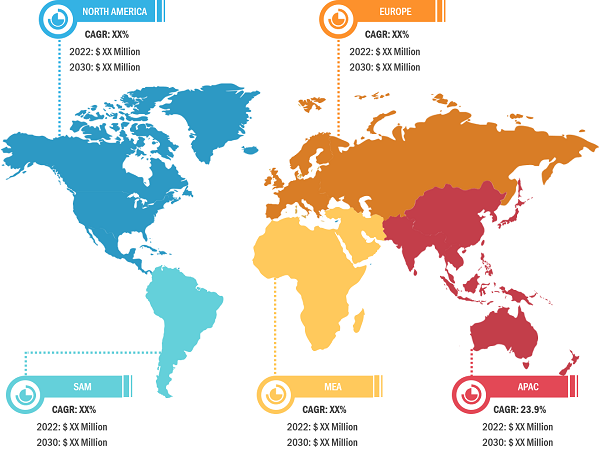Increase in Adoption of Consumer Electronics Boosts Embedded Non-Volatile Memory Market Growth
According to our latest study on “Embedded Non-Volatile Memory Market Forecast to 2030 – Market Size and Forecast (2020–2030), Global and Regional Share, Trend, and Growth Opportunity Analysis Report Coverage – by Product and Application,” the embedded non-volatile memory market size was valued at US$ 729.05 million in 2022 and is expected to reach US$ 3,732.95 million by 2030. The embedded non-volatile memory market is expected to record a CAGR of 22.6% from 2022 to 2030.
Products in embedded non-volatile memory market play a crucial role in the consumer electronics industry. Embedded non-volatile memory is placed in microcontrollers, which are used in embedded systems and further integrated into numerous consumer electronic devices such as cameras, smartphones, smartwatches, microwave ovens, washing machines, smart TVs, tablets, printers, gaming consoles, smart speakers, digital cameras, and home security systems. Products in embedded non-volatile memory market support data storage that is found in microcontrollers and other electronics. The user keeps this data for further processing, including data redundancy, trimming, programming, identification, and encryption. Products in embedded non-volatile memory market allow users to store data in the absence of electric power, which increases the demand among consumers and drives the global embedded non-volatile memory market.
Embedded Non-Volatile Memory Market – by Region, 2022 and 2030
Embedded Non-Volatile Memory Market Size and Forecast (2020 - 2030), Global and Regional Share, Trend, and Growth Opportunity Analysis Report Coverage: By Product (eFlash, eE2PROM, FRAM, and Others), Application (Consumer Electronics, Automotive, Robotics, and Others), and Geography
Embedded Non-Volatile Memory Market Growth Report by 2030
Download Free Sample
Source: The Insight Partners Analysis
Products in embedded non-volatile memory market used in memory cards and USB sticks that are integrated into a variety of consumer devices such as smartphones, smartwatches, and digital cameras for data storage. These devices use embedded MultiMediaCard (eMMC) memory chips to store controller code in storage drives and personal electronic devices. The growing adoption of consumer electronics devices among consumers is driving the embedded non-volatile memory market. According to Canalys, the demand for smartwatches has grown by 3%, and for basic watches, the demand increased by 21% in 2022. Consumers across the globe adopt smartwatches to track fitness and health data. Major players in the smartwatch industry are engaging in adding features to smartwatches to attract more customers. For instance, in July 2023, Apple Inc. developed a smartwatch capable of identifying Parkinson’s disease, diabetes, and Lyme disease, which is expected to be popular among the elderly population. The embedded non-volatile memory supports embedded systems to process the data generated by smartwatches to track users’ health and fitness.
Moreover, new specifications are currently being developed by server, storage, and application vendors to improve product interaction with NVM. The constant generation of new mobile devices fuels the expansion of NVM products. In 2021, 30-nm node technologies were ramping up, 20-nm node technologies were transitioning to mass production, and a 10-nm node technology was developing to fulfill the demand. Furthermore, to serve a massive amount of data correspondence, the future market requires high-speed operation up to about 1,500 MB/s. These factors are fueling the production of consumer electronics, thereby boosting the demand for embedded non-volatile memory.
The expansion of consumer electronics and automotive industries is boosting the demand for embedded non-volatile memory among manufacturers. The growing demand for embedded non-volatile memory among automotive manufacturers encourages market players to increase their production and commercialize embedded non-volatile memory. For instance, in October 2023, Floadia Corporation raised approximately US$ 7.04 million (JPY 1.05 billion) in funding from Japan Finance Corporation, Cypress Capital, and Inabata & Co. for commercializing its embedded flash memory IP. This funding will support Floadia Corporation in strengthening its production and sales activities by promoting its primary business of embedded flash memory IP cores. Floadia Corporation increases the production of embedded non-volatile memory to fulfill the growing need of semiconductor manufacturers.
Moreover, many international and domestic players are raising funding for developing embedded non-volatile memory tech. eFlash is a low-cost and energy-efficient embedded non-volatile memory technology used in numerous battery-powered devices such as medical wearables, wireless sensors, and various autonomous robots. This further fulfills the future need for computing technologies. These factors are expected to boost the embedded non-volatile memory market growth in the near future.
The embedded non-volatile memory market is categorized based on product, application, and geography. Based on product, the embedded non-volatile memory market is segmented into eFlash, eE2PROM, FRAM, and others. By application, the embedded non-volatile memory market is segmented into consumer electronics, automotive, robotics, and others. The embedded non-volatile memory market, based on geography, is categorized into North America, Europe, Asia Pacific, the Middle East & Africa, and South America.
Taiwan Semiconductor Manufacturing Company Limited, Globalfoundries Inc., Hua Hong Semiconductor Limited, Microchip Technology Inc., SMIC, Texas Instruments Incorporated., Tower Semiconductor, United Microelectronics Corporation, and Synopsys Inc. are among the key players operating in the embedded non-volatile memory market.
Contact Us
Phone: +1-646-491-9876
Email Id: sales@theinsightpartners.com